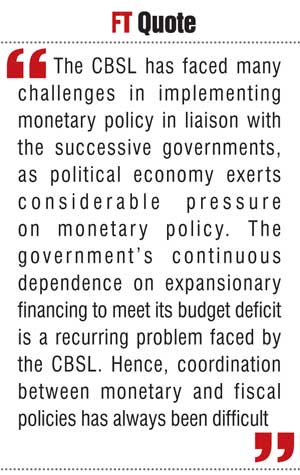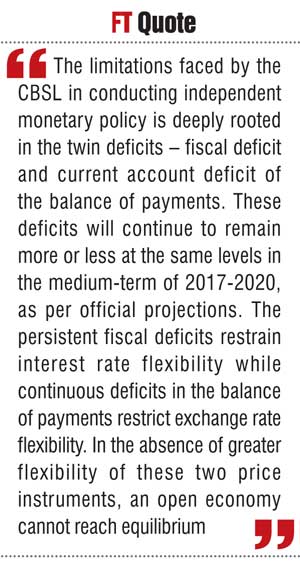Friday Oct 31, 2025
Friday Oct 31, 2025
Monday, 30 October 2017 00:01 - - {{hitsCtrl.values.hits}}

Prof. H. A. de S. Gunasekera
This is an abridged version of the Prof. H.A.de S. Gunasekera Memorial Oration delivered at University of Peradeniya on 24 October
I consider it a great privilege and an honour to deliver the Professor H. A. de S. Gunasekera memorial oration to pay tribute to our most respected teacher, scholar, author, top-level administrator and policymaker.
 This year’s oration is even more significant, as it coincides with the 75th anniversary celebrations of the University of Peradeniya and the Department of Economics. I take this opportunity to extend my best wishes to this prestigious University and the Economics Department from where I began my academic life.
This year’s oration is even more significant, as it coincides with the 75th anniversary celebrations of the University of Peradeniya and the Department of Economics. I take this opportunity to extend my best wishes to this prestigious University and the Economics Department from where I began my academic life.
Prof. Gunasekera, inspiring teacher and visionary
I was fortunate to be in the last batch of students of late Prof. Gunasekera at Peradeniya before he moved to Colombo to take up the position of Secretary to the Ministry of Planning and Economic Affairs. I recall with gratitude how lucidly the stern-looking professor taught us the rigorous theories of Monetary Economics in his own style.
His book, ‘From Dependent Currency to Central Banking in Ceylon: An Analysis of Monetary Experience 1825-1957’, which was based on his doctoral thesis at the London School of Economics, remains a seminal contribution to date in the field of central banking and monetary policy. He asserted, in his book, that the Central Bank had not justified its existence in its formative years, as it failed to prevent the volatility of money supply emanated from fiscal deficits and export fluctuations.
These arguments of Prof. Gunasekera on the limitations of the central bank in a developing economy saddled with the twin objectives of economic development and stabilisation still remain valid.
Central banking was at the very centre of the scholarly work of Prof. H.A.de S. Gunasekera, and therefore, I have chosen the theme on ‘The Politics of Central Banking in Sri Lanka’ for this oration to pay tribute to my Guru. Having returned to academia after a long spell in the Central Bank, I have had the rare opportunity to reflect on both monetary theory in textbooks and monetary policy in practice. That too prompted me to focus on this theme.
The Central Bank, which was not a popular subject among the general public previously, hits headlines now on a daily basis for all the wrong reasons.
In this oration, I explore how far the Central Bank of Sri Lanka (CBSL) has been able to conduct monetary policy independent of political pressures.

Central bank’s relationship with the government
The relationship between the central bank and the government varies from country to country. There is general consensus that a country’s central bank should be completely independent from the government, as political pressures could hurt the bank’s ability to conduct sound monetary management aiming at price stability, which has surfaced worldwide as the core responsibility of the monetary authority nowadays.
The alternative view is that the central bank should be under the direct control of the government since the bank should respond to the will of the people in a democratic society. In practice, however, central banks operate between these two extreme paradigms, and enjoy different degrees of independence in each country.
Political authorities usually have a tendency to incur high government expenditure for populist welfare measures offering various handouts, subsidies and income transfers to households and creating jobs in the public sector so as to retain their electoral vote base. These policies lead to large budget deficits which are then financed through borrowings.
The unfinanced portion of the deficit has to be accommodated by the central bank which is capable of using its monopoly power to print paper money or ‘fiat money’, to lend to the government. The revenue generation by the government through such money creation, known as ‘seigniorage’, results in an increase in the central bank’s monetary base (consisting of currency in circulation among the public plus commercial bank deposits with the central bank) with multiple expansion of the aggregate money supply causing inflation.
In order to insulate monetary management from such inflation-biased political pressures, central bank independence becomes crucial. It is broadly recognised that the central banks which are more independent perform better in achieving their main objective – price stability.
The CBSL (then, Central Bank of Ceylon), which was established in 1950 as the country’s monetary authority, has been entrusted with the tasks of issuing currency and implementing monetary policy, among other functions. The CBSL has been conducting monetary policy within the frameworks of the economic ideologies of different political regimes over time.
Challenges faced by the Central Bank
The CBSL has faced many challenges in implementing monetary policy in liaison with the successive governments, as political economy exerts considerable pressure on monetary policy. The government’s continuous dependence on expansionary financing to meet its budget deficit is a recurring problem faced by the CBSL. Hence, coordination between monetary and fiscal policies has always been difficult.
In the event of any disagreement on monetary policy between the Minister in charge of the subject of Finance and the Monetary Board, the Minister has the authority to overrule the decision of the Board, and to direct the Board to carry out the decision in accordance with the opinion of the government. This provision has considerably weakened the autonomy of the CBSL as the directives given by the government are mostly inflation-biased.
Central bank independence
It is widely recognised that a sufficiently high level of central bank independence is desirable to achieve price stability. The most prominent argument put forward in favour of independent central banking is the time inconsistency problem. This problem arises when a policymaker prefers a certain policy to be implemented in a future period, but it is no longer desirable when that period actually comes. So, the policymaker has to revise the pre-announced plan.

As regards monetary policy, the time inconsistency problem occurs when politicians attempt to manipulate the trade-off between unemployment vis-à-vis inflation. In order to retain popularity ahead of an election, for example, the government may be tempted to reduce interest rates so as to induce employment. This helps to boost employment and incomes in the short-run delivering the anticipated political gains, but it causes inflation in the long run.
The actual or de facto independence enjoyed by the central bank may be quite different from the de jure independence provided under the law due to interferences by the government from time to time. A good example is the decision taken by the present Government in 2015 to transfer the subject of central banking and monetary policy from the Ministry of Finance to the Ministry of National Policies and Economic Affairs headed by the Prime Minister. This was done through a gazette notification without even amending the Monetary Law Act.
According to this new arrangement, the Ministry has been assigned the functions of formulation of monetary policies and macroeconomic management in coordination with the CBSL, and liaising with donor agencies and international financial institutions, among others. This seems to reduce the status of the CBSL to a mere consultative body. The Ministry has also been given the mandate to implement several Acts including the Monetary Law Act, which had been the prerogative of the CBSL. Obviously, this retards the limited independence enjoyed by the CBSL thus far.
At present, the Monetary Board, which governs the CBSL, has five members consisting of the Governor as the Chairman, Secretary to the Ministry of Finance and three appointed members. The Governor of the CBSL is appointed by the President on the recommendation of the Minister of Finance. This is a common feature in many other countries. The three appointed members are also assigned on the same basis. Thus, the Government has direct influence over these appointments.
Monetary politics at play
The individuals who had held the position of Governor in the earlier decades displayed much integrity reflecting their sound professional background and strong personalities. This enabled the CBSL to keep its distance from politics. The cultured political environment prevalent during that period too helped to nurture professional central banking. The situation, however, has deteriorated in recent decades with undue involvements of some former Governors, in what I call, ‘monetary politics’.
A few years ago, for instance, a former Governor was alleged to have been involved in bidding for the Commonwealth games and lobbying for the government abroad lavishly spending public funds. The ongoing investigations on the well-publicised Treasury bond scandal reveal the present Government’s direct involvement in the bond auctions and a former Governor’s links with a market player. These alleged malpractices have posed enormous threats to the independence and credibility of the CBSL.
The independence of the CBSL is constrained by the fact that it has to perform multiple agency functions on behalf of the government. Apart from the conduct of monetary policy, the Central Bank has to act as the fiscal agent and the manager of the public debt, and also as the manager of the employees’ provident fund. At the same time, the foreign reserves of the country come under the purview of the CBSL.
Fiscal dominance over monetary policy
Fiscal deficits have been cited as a major cause of persistent inflation in developing countries due to monetisation of a significant share of the deficits that are not financed either by foreign borrowings or domestic borrowings. In general, the governments prefer this type of ‘inflation taxation’ to avoid becoming unpopular by collecting more direct and indirect taxes from citizens.

Although the monetarists led by Milton Friedman argued that a country’s central bank can arrest inflation by controlling the money supply, this link can be severely weakened by fiscal dominance over monetary policy. The government usually prepares its annual budget on its own without considering the monetary implications. Then, the CBSL is compelled to accommodate the unfinanced portion of the budget deficit. As a result, fiscal operations can have a significant influence on the price level, as expounded in recent monetary theories.
Hence, the central bank with the mandate of price stability should not only put its house in order but also should insist the fiscal authority to adopt harmonious budgetary policies to secure price stability. It is just like performing a symphony orchestra with different musical instruments in harmony.
In an effort to arrest fiscal dominance in Sri Lanka, the Fiscal Management and Responsibility Act was enacted in 2002 with a view to introduce fiscal rules targeting low budget deficit and public debt. But these targets have never been fulfilled due to excessive government expenditure.
As a result, there has been increasing dependency on seigniorage to meet the fiscal deficits in recent years. The total outstanding amount of CBSL’s net credit to government has increased rapidly since 2010 causing monetary expansion.
Monetary policy rules vs. discretion
The superiority of rules vis-à-vis discretion has been a central theme of monetary policy literature over the last three decades. Central banks need to adjust the policy interest rates in a systematic manner in response to changes in inflation and macroeconomic activity, as prescribed in the famous Taylor-rule.
Based on my policy rate simulations, I find that the monetary policy conducted by the CBSL has been discretionary rather than rule-based throughout the post-liberalisation period. A possible reason for this might be the CBSL’ concern about the adverse fiscal implications of upward rate adjustments. The discretionary rate adjustments have made monetary policy pro-cyclical aggravating macroeconomic imbalances. They have had adverse implications for savings, investment and economic growth.
Since 2010, the CBSL has reduced its policy rates gradually with the objective of lowering market interest rates so as to promote investment and economic activities. Given the economic uncertainties, however, businessmen opt to engage in activities that bring them quick profits, rather than investing in agriculture or industry which involve longer gestation periods and greater risks.
Hence, a significant increase in investments is evident in activities such as real estate development, construction, high-rise apartment buildings, trading and other service-related ventures which generate quick returns with minimum risks. Greater availability of lending and leasing facilities at low interest rates also boosted importation of durable consume goods such as motor vehicles exerting considerable pressures on the balance of payments.
Exchange rate management
The external sector imbalances also pose severe challenges to monetary management. The current account of the balance of payments has been in deficit continuously, reflecting the sluggish export performance and rapid increase in imports. If not for the migrant worker remittances, which are on a downward trend now, the balance of payments situation would have been much worse. The external deficits have been financed through international sovereign bonds, commercial borrowings and short-term credit further enhancing the debt service burden.
The CBSL had attempted to maintain a pre-determined exchange rate by selling foreign exchange to the market until recently. It sold considerable amounts of its foreign reserves to the foreign exchange market to defend the rupee. This led to an appreciation of the real exchange rate eroding export competitiveness in the face of inflationary pressures.
The limitations faced by the CBSL in conducting independent monetary policy is deeply rooted in the twin deficits – fiscal deficit and current account deficit of the balance of payments. These deficits will continue to remain more or less at the same levels in the medium-term of 2017-2020, as per official projections. The persistent fiscal deficits restrain interest rate flexibility while continuous deficits in the balance of payments restrict exchange rate flexibility. In the absence of greater flexibility of these two price instruments, an open economy cannot reach equilibrium.
As demonstrated in the ‘Impossible Trinity’ theorem, a monetary authority can choose only two out of the three policy options – stable exchange rate, free capital flows and independent monetary policy. Based on this premise, I argue that the CBSL has been compelled to sacrifice independent monetary policy, as it uses the exchange rate as a nominal anchor when there exist capital flows in the form of portfolio and foreign direct investments and foreign borrowings.
Need to mitigate monetary politics
The CBSL finds it extremely hard to insulate monetary policy from the pressures of inflation-biased and electorate-targeted populist policies of political authorities, and to execute its policy instruments independently to achieve price stability.
I find that amid fiscal dominance, the Central Bank has been severely constrained in adopting rule-based decisions, and as a result, monetary policy has been discretionary and pro-cyclical. The use of the exchange rate as a nominal anchor in the context of capital flows has compelled the Central Bank to give up independent monetary policy.
The CBSL is now in the process of shifting monetary policy towards an inflation targeting framework, under which the central bank itself will be accountable for attaining price stability. I consider this a suicidal attempt by the CBSL, as the monetary authority alone cannot fulfill inflation targets, whilst the fiscal authority fuels inflation by resorting to seigniorage for its solvency. Sensible conduct of monetary policy, therefore, requires stringent fiscal rules for which unwavering political commitment is imperative.
To recapitulate, I contend that central banking in Sri Lanka is heavily influenced by Monetary Politics, rather than by Monetary Economics.
I have demonstrated in this presentation, quite unintentionally of course, that monetary management in Sri Lanka is still subject to the constraints of fiscal and foreign exchange imbalances, as rightly predicted by Professor H. A.de S. Gunasekera more than five decades ago.
(The writer is Emeritus Professor, Open University of Sri Lanka.)